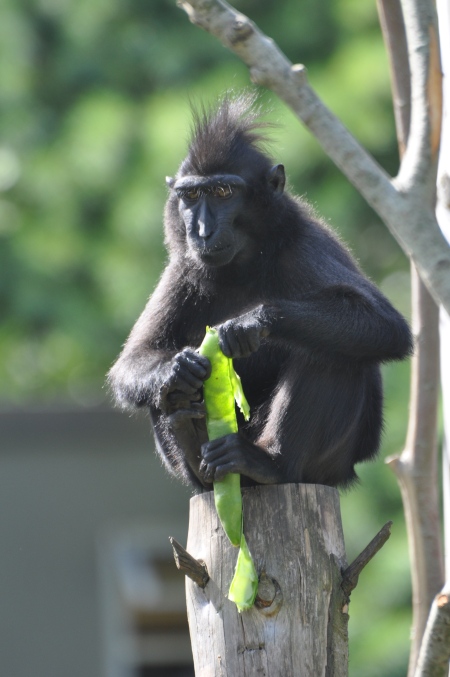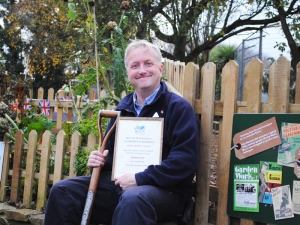
Squirrel Monkey exploring scented herb enrichment, Newquay Zoo, October 2015 (Image: Nicole Howarth, Newquay Zoo)
This weekend I was busy clearing some of the World War Zoo Garden Allotment crops at Newquay Zoo to prepare for the autumn season. I dropped off a pile of fresh herb clippings (Lemon Balm, fresh Mint) in our animal food preparation room for Carnivore and Primate sections to use to scent mark and enrich some of our enclosures.
Primate Keeper Nicole Howarth grabbed a handful of these herbs and dropped some Lemon Balm and fresh Mint bundles off along our Monkey Walk enclosures. You can see one of our Squirrel Monkeys exploring this new scent and probably bug-hunting through the bundle, harvested minutes before.

Squirrel Monkey exploring scented herb enrichment, Newquay Zoo, October 2015 (Image: Nicole Howarth, Newquay Zoo)
We’re harvesting the last of the Rainbow or Rhubarb Chard ahead of the first frosts. This colourful bundle was thrown to our Critically endangered group of Sulawesi Macaque monkeys by this Sunday’s Junior Keeper (who coincidentally had the unusually planty surname of Chard) with a few small Globe artichoke heads for good measure. A lot of the leaf holes are not snail damage, I discovered, but peacocks! Apparently the Macaque monkeys enjoyed it all with great gusto, sap, leaf and stem!

A colourful bundle of Chard in our ‘Victory’ Harvest 70 years on, Newquay Zoo, 2015 (Image: Mark Norris
Keepers are free to come and raid the allotment as they wish, just letting me know what they’ve taken and which animals benefitted. Keepers have been known (as I have on odd occasions) to grab some of this fresh mint for the odd cup of soothing fresh herbal tea, one keeper swears by Lemon balm tea which I have yet to try.
Nicole Howarth gets the whole sustainability thing of the garden, albeit 1940s self-sufficiency in response to gunpoint and jackboot. She has recently finished a pioneering MSc in Zoo Sustainability, focussed on Newquay Zoo, ‘Assessing environmental impacts in zoos to inform sustainable collection planning a case study at Newquay Zoo’ by Nicole Fenton Howarth for an MSc in Zoo Conservation Biology July 2015.
This isn’t the first time that Nicole on our Primate section has used our garden produce. Some herbs and vegetables we harvest in their seed or flowers stage to make them a little more unusual ‘picky’ and tactile enrichment for our animals. Not the kind of things you can easily buy in the shops!
Some of the veggies in flower or colourful chard are so attractive, it’s tempting to leave them a little longer to be admired in flower by visitors. Thistly looking Globe Artichokes sometimes spring into ‘flower’, these ‘flower silks’ prove another interesting challenge to monkey fingers.

On the lawn next to the lion enclosure, bundles of herbs and some garlic seed heads gathered for our monkeys, Newquay Zoo, October 2015 (Image: Mark Norris)
Overall it has been a reasonable 2015 growing season with a few failures – broad beans, peas – probably from dryness or tired soil. At least the garden has added a small amount of colour as well as fresh animal food to Newquay Zoo’s overall gardens this year which we are proud to have seen win a Newquay in Bloom award 2015 for the Leisure Attraction Class following our 2014 win for our ‘Restaurants and Tea Gardens’ area.
Black Gold – Compost
The wartime allotment garden is going slowly to bed for the winter. Buckets of rich dark humus from part of our fabulous Newquay Zoo compost heaps have been scattered all over the plot to break down and add texture to our slaty clay soil through the frost season. The really big bundles of hoofstock bedding straw and green waste go offsite to local farm composting, otherwise Newquay Zoo would be a towering huge compost heap of Dickensian proportions. It’s all a not so glamorous part of our ISO 14001 green or environmental certification going on in front and behind the scenes at Newquay Zoo.
Surprisingly we did manage to get a perfect balanced Ph reading (not too acid, not too alkaline) last year through on soil testing of our allotment.

My battered compost bucket of rich loveliness – weeds in, compost out at Newquay Zoo, 2015. Image: Mark Norris.

Our Powerhouse and peacock haunts! Site and Gardens section’s Compost heaps behind the scenes and the towering platforms of the Macaque monkey enclosure at Newquay Zoo. I just add buckets of weeds and old veg bits to the mix. Image: Mark Norris.

Modern Growmore next to the campaign signs of what replaced the National Growmore Campaign, Dig For Victory!
World War Zoo Gardens Project, Newquay Zoo, January 2015
One half of the garden has had its ‘Dandruff shampoo advert’ dressing of wartime National Growmore Fertiliser, the other half is again seeded with autumn mix Green manure (Crimson and Broad Leaf Clover, Rye Grass and White Tilney Mustard). This year’s half and half ‘Dandruff style challenge’ seemed to show no noticeable difference throughout the 2015 growing season. https://worldwarzoogardener1939.wordpress.com/2015/03/04/national-growmore-fertiliser-a-brief-history/
Not enriching the soil too much is important in the herb patch sections of the garden, but they do tend to merge and get tangled up in each other in a small garden plot as you can see in how the poppies (first flowering here this year) are flowering and seeding amongst the last of the Chard.
A reminder that in less than a month, it will soon be Poppy day, Armistice or Remembrance Sunday, our garden having a simple memorial function for all the zoo keepers and gardeners lost in both World Wars: https://worldwarzoogardener1939.wordpress.com/ww1-related-posts/

Poppies amongst the Autumn harvest, World War Zoo garden project, Newquay Zoo, 2015. Image: Mark Norris
Sharing plant knowledge with Keepers
In my 2014 ABWAK journal RATEL article for keepers, I used this garden as an opportunity to promote to keepers that BIAZA Plant Working Group has compiled a Wikisite listing of animals and plants www.zooplants.net with reference to various aspects of plant nutrition, enrichment or toxicity for each animal. Any adverse reactions including death in the past have been noted by keepers on this worldwide wiki page / forum.
The BIAZA Plant Working Group has also in the past compiled a database of browse and poisonous plants. This was also mentioned in my article Enrichment, visitor engagement or history your zoo animals can eat? The ongoing role of the Wartime Zoo Keepers’ Garden at Newquay Zoo article for ABWAK journal RATEL 41(1) March 2014, pp 5-9.
Here is the plant list of veg, fruit and herbs grown successfully or not so far since 2009.
Plants list – World War Zoo Gardens project, Newquay Zoo (2009-15)
- Allium cepa – (Spring) Onion
- Allium sativum – Garlic
- Allium schoenoprasum – Chives
- Allium tuberosum – Garlic Chives
- Allium ampeloprasum – Leek
- Anthriscus cerefolium – Chervil
- Borago officinalis – Borage (blue or white)
- Beta vulgaris – Beet varieties (rainbow, rhubarb chard)
- Beta vulgaris subsp. cicla – Perpetual Spinach
- Brassica oleracea – Kale & cabbage varieties,Savoy & Pak Choi
- Calendula officinalis – Pot or English Marigold
- Cynara cardunculus var. scolymus – Globe Artichoke
- Eruca sativa – (Salad) Rocket
- Fragaria × ananassa – Strawberry
- Foeniculum vulgare – Fennel
- Galium odoratum – Sweet Woodruff
- Helianthus annuus – Sunflower
- Lavandula angustifolia – English Lavender
- Lactuca sativa – Lettuce
- Melissa officinalis – Lemon balm
- Mentha x piperita – Peppermint
- Mentha spicata – Spearmint
- Nepeta cataria – Catnip / Wild Catmint
- Petroselinum crispum – Parsley
- Pisum sativum – Pea
- Rosmarinus officinalis – Rosemary
- Rubus fruticosus – Bramble or Blackberry
- Rubus idaeus – Raspberry
- Taraxacum officinale – Dandelion
- Teucrium marum – Cat Thyme
- Tropaeolum majus – Nasturtium
- Vicia faba – Broad Bean
- Zea mays – Maize or Sweetcorn
At some point we will update our slightly chaotic 2010 list of heritage 1940s vegetables: https://worldwarzoogardener1939.wordpress.com/2010/05/17/a-first-abc-of-wartime-vegetable-varieties-our-%e2%80%98free-gift%e2%80%99-to-you-to-celebrate-plant-conservation-day-2010-18-may-2010-from-the-world-war-zoo-gardens-at-newquay-zoo/
A big thanks to our Keeper and Site / Gardens Teams again this year. Happy Harvesting!
Posted by Mark Norris, World War Zoo Gardens at Newquay Zoo.


























